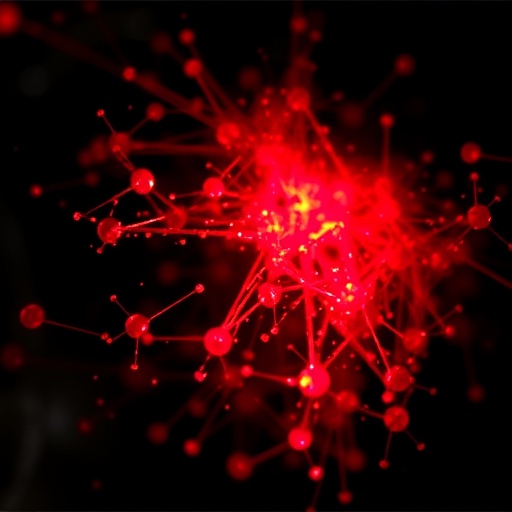In a groundbreaking exploration of the tumor microenvironment, recent research has unveiled intricate interactions between CD8+ T cells and specific subpopulations of both tumor cells and antigen-presenting cells (APCs). This study highlights the nuanced cellular choreography underlying immune responses in melanoma, revealing preferential binding patterns that could redefine therapeutic strategies. Utilizing comprehensive molecular annotations and cell cluster analyses, investigators have mapped out the complex dialog among immune and tumor cells, providing fresh insight into immune evasion and antitumor immunity.
Melanoma, a notoriously heterogeneous malignancy, exhibits a vast array of cellular states that influence its response to immune surveillance. By dissecting the tumor landscape, researchers categorized melanoma cells into distinct subtypes based on gene signatures linked to melanocytic lineage and neural crest-like features. Beyond these established phenotypes, they identified tumor cell subpopulations enriched for gene programs associated with immune responses—including antigen presentation pathways and interferon signaling—as well as stress and hypoxia adaptations, such as hypoxia-inducible factor (HIF) signaling cascades. These findings underscore the plasticity of melanoma cells as they modulate their phenotype in the context of immune interaction and microenvironmental stress.
Crucially, tumor cells within these immune-response-associated subpopulations exhibited heightened expression of ligands known to mediate T cell recruitment and engagement. Molecules such as chemokines CCL5 and CXCL9/10 and adhesion markers like ICAM1 were significantly upregulated, fostering enhanced formation of immune synapses with CD8+ T cells. Moreover, immune checkpoint ligands including PD-L1 were prominently expressed, highlighting a sophisticated balance between attracting cytotoxic T cells and modulating their activation states within the tumor microenvironment.
Parallel analyses of APC subsets revealed an equally diverse cellular milieu infiltrating the tumor. By profiling monocytes, macrophages, dendritic cells (DCs), and B/plasma cells isolated directly from patient samples, investigators delineated a spectrum of immune states marked by unique gene expression patterns. Among these, macrophages characterized by high C1q expression—both lipid-associated and inflammatory phenotypes—stood out for their preferential association with clusters enriched in CD8+ T cells. These macrophage populations expressed a complex array of ligands that not only attract T cells through chemokine signaling axes but also convey co-stimulatory and inhibitory signals via molecules such as PD-L1 and CD80, modulating T cell efficacy in situ.
Dendritic cells similarly displayed functional specialization. Particularly, plasmacytoid DCs and mature regulatory DCs (mregDCs), known to orchestrate immune tolerance and activation, were prevalent within CD8+ T cell-enriched clusters. Their ligand profiles indicated capabilities to both recruit and regulate T cells via chemokine-receptor interactions and checkpoint molecules. Concomitantly, plasma cells were found to cluster with T cells, suggesting a coordinated humoral and cellular immune response embedded within the tumor microenvironment.
This meticulous characterization of cell–cell interactions leveraged a multi-dimensional ligand–receptor communication analysis, enabling the researchers to predict functional contacts underpinning T cell localization and engagement. By integrating expression data for chemokines, adhesion molecules, immune checkpoints, and co-stimulatory factors, the study painted a detailed map of molecular crosstalk underpinning heterotypic CD8+ T cell clusters. These clusters represent functional hubs where immune effector cells physically interface with tumor and APC subpopulations, potentially dictating the immunological outcome.
The preferential association of CD8+ T cells with specific tumor and APC subtypes reflects an orchestrated immune microenvironment shaped by the tumor’s adaptive strategies and the immune system’s countermeasures. Melanoma cells from immune-primed states emit cues that both attract and regulate cytotoxic lymphocytes, creating a dynamic interplay that modulates immune effectiveness. Meanwhile, macrophage and dendritic cell populations adopt roles that can either amplify or inhibit T cell responses, depending on their molecular milieu.
Insights from this study challenge the simplistic view of immune infiltration as a mere accumulation of effector cells and instead emphasize cellular heterogeneity as a determinant of immune competence within tumors. The identification of ligand–receptor pairs mediating T cell attraction and modulation offers potential targets for therapeutic intervention, particularly in overcoming immune checkpoint-mediated suppression and enhancing T cell infiltration and function.
Beyond therapeutic implications, the study advances the conceptual framework of tumor-immune ecosystem architecture. It reveals how melanomas sculpt their microenvironment not only by altering intrinsic gene expression programs but also by recruiting and conditioning immune subsets to form distinct spatial clusters. These heterotypic clusters likely underpin differential patient responses to immunotherapy and represent critical nodes for investigating resistance mechanisms.
Methodologically, this research integrates high-resolution single-cell RNA sequencing, advanced cell clustering algorithms, and comprehensive ligand-receptor interaction modeling. The precision in defining cellular subpopulations within both tumor and immune compartments allowed for unprecedented granularity in understanding spatial and functional relationships. This approach represents a paradigm shift, moving from bulk tumor profiling toward dissecting the interactive multicellular networks crucial for effective antitumor immunity.
Importantly, the study draws on a rich foundation of prior research into melanoma cellular heterogeneity and myeloid cell biology, synthesizing these insights into a cohesive model that specifically connects T cell localization with tumor and APC phenotypes. By anchoring findings in known gene signatures and biological pathways, the results gain robustness and facilitate translational applications.
In summary, these findings illuminate a new dimension of tumor immunology: the formation of heterotypic CD8+ T cell clusters defined by selective conjugation to tumor and antigen-presenting cell subpopulations. This selective binding is orchestrated through a complex network of ligand-receptor interactions, balancing attraction, synapse formation, activation, and inhibition. Understanding and manipulating this cellular choreography holds promise for enhancing immune-based therapies and combating tumor immune evasion, ultimately improving patient outcomes in melanoma and potentially other cancers.
Subject of Research:
Investigation of the interaction between CD8+ T cells and specific melanoma tumor cell and antigen-presenting cell subpopulations, focusing on ligand–receptor-mediated communication within the tumor microenvironment.
Article Title:
Tumour-reactive heterotypic CD8 T cell clusters from clinical samples.
Article References:
Ibáñez-Molero, S., Veldman, J., Simon Nieto, J. et al. Tumour-reactive heterotypic CD8 T cell clusters from clinical samples. Nature (2025). https://doi.org/10.1038/s41586-025-09754-w
Image Credits:
AI Generated




